Sump - removal and refitting
Note: New gaskets and sealing strips must be used on refitting.
Removal
1 Disconnect the battery negative lead.
2 Drain the engine oil.
3 Remove the starter motor as described in Chapter 5, Part A.
4 Apply the handbrake, jack up the front of the car and support it on stands (see “Jacking and Vehicle Support”).
5 Unbolt and remove the cover plate from the clutch housing (see illustration).
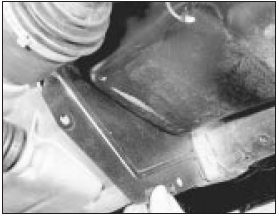
8.5 Remove the clutch housing cover plate
6 Unbolt and remove the engine splash shield at the crankshaft pulley end (see illustration).
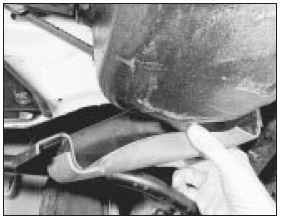
8.6 And the right-hand engine splash shield
7 Unscrew the sump securing bolts progressively and remove them.
8 Remove the sump and peel away the gaskets and sealing strips.
Refitting
9 Make sure that the mating surfaces of the
sump and block are clean, then fit new end
sealing strips into their grooves and stick new
side gaskets into position using thick grease.
The ends of the side gaskets should overlap the seals. On later models a one-piece sump gasket is used. Before fitting, apply sealer to the joints of the cylinder block and rear oil seal carrier, and cylinder block and oil pump housing (four locations). Without applying any further sealer, locate the gasket into the grooves of the oil seal carrier and oil pump housing (see illustrations). To retain the gasket insert two or three studs into the cylinder block if necessary and remove them once the sump is in place.
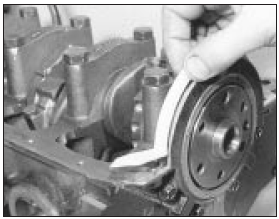
8.9a Fitting the sump sealing strips . . .
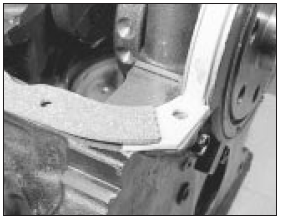
8.9b . . . followed by the side gaskets with their ends overlapped
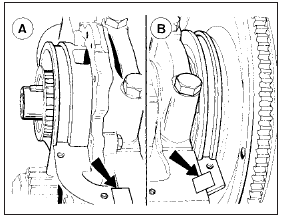
8.9c Apply sealer to the areas shown when fitting a one piece sump gasket
A Oil pump housing-to-block joint B Rear oil seal carrier-to-block joint
10 Offer up the sump, taking care not to displace the gaskets and insert the securing bolts. Tighten the bolts in two stages to the final torque given in the Specifications.
11 Refit the cover plate to the clutch housing and refit the engine splash shield.
12 Refit the starter motor.
13 Fill the engine with oil and reconnect the battery.
See also:
Carburettor fuel system
The fuel system on all models with carburettor induction is
composed of a centrally mounted fuel tank, a fuel pump, a carburettor and an air
cleaner.
The fuel tank is mounted under the floor pan ...
Brake hydraulic fluid renewal (Every 36 000 miles (60 000 km) or 3 years)
1 An assistant and bleeding equipment will
be needed. A considerable quantity of
hydraulic fluid will be required - probably
about 2 litres (nearly half a gallon).
2 Slacken the front wheel nuts. ...
Bonnet release cable - removal and refitting
Removal
1 Working inside the vehicle, extract the three
screws and remove the steering column
shroud. Open the bonnet. If the cable is broken,
the release latch must be operated using a
suitably ...
